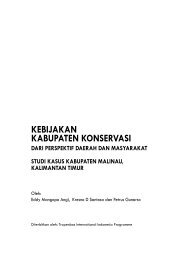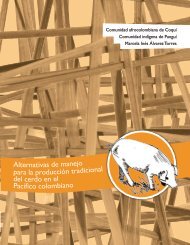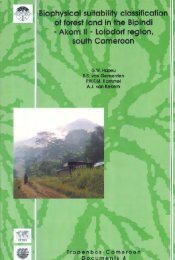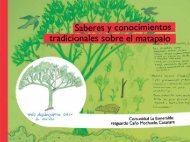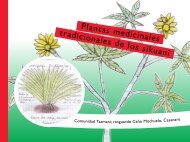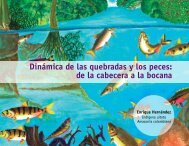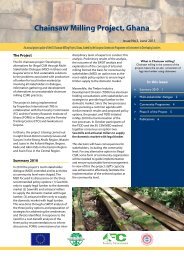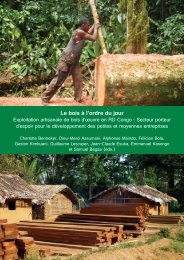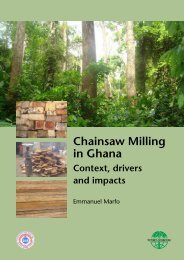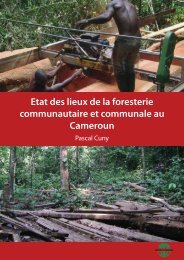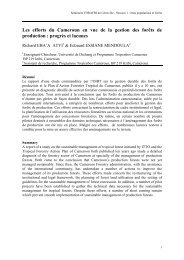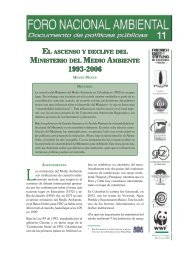Download the publication - Tropenbos International
Download the publication - Tropenbos International
Download the publication - Tropenbos International
You also want an ePaper? Increase the reach of your titles
YUMPU automatically turns print PDFs into web optimized ePapers that Google loves.
Plant diversity in a Central African rain forest: Implications for biodiversity conservation in Cameroon<br />
was collected. The study also involved <strong>the</strong> collection of fertile specimens encountered<br />
in plots, vegetation types and specific habitats such as exposed rocks and riverbanks.<br />
Criteria for taxa inclusion<br />
A plant species checklist was generated from <strong>the</strong> inventory data, from <strong>the</strong> plant<br />
collections made during <strong>the</strong> study, and from specimens previously collected in <strong>the</strong><br />
area by o<strong>the</strong>r scientists, stored in <strong>the</strong> Cameroon and Wageningen herbaria.<br />
Fur<strong>the</strong>rmore, a taxonomic search of potential taxa of high conservation priority such<br />
as endemic, rare, new and threatened species was carried using existing floras and<br />
monographs (Keay & Hepper, 1954-1972; Aubréville & Leroy, 1961-1992;<br />
Aubréville & Leroy, 1963-2000; Lebrun & Stork, 2003; Satabié & Leroy, 1980-1985;<br />
Satabié & Morat, 1986-2001), <strong>the</strong> IUCN (2002) red list categories, and <strong>the</strong> WCMC<br />
(1998) world list of threatened trees. On <strong>the</strong> basis of this information, a list of 141<br />
species of high conservation values was produced with information on <strong>the</strong>ir habit,<br />
guild, star category (Table 5.1) and chorology. In this list, priority was given to taxa<br />
that are strictly endemic to <strong>the</strong> Campo-Ma’an area. Followed by species that are<br />
endemic to southwestern Cameroon (also occurring in Bipindi and Lolodorf areas) or<br />
Cameroon and Lower Guinea endemics (especially if <strong>the</strong>y reach <strong>the</strong>ir nor<strong>the</strong>rn or<br />
sou<strong>the</strong>rn limit of distribution in Campo-Ma’an).<br />
Taking into consideration <strong>the</strong> fact that strict and narrow endemic species are highly<br />
vulnerable to human disturbance and o<strong>the</strong>r forms of environmental changes, <strong>the</strong>y are<br />
often indicators of rich biodiversity, and <strong>the</strong>ir distribution is frequently used for <strong>the</strong><br />
identification of biodiversity hotspots (Myers, 1988; Williams, 1993; Heywood &<br />
Watson, 1995). Based on <strong>the</strong>ir spatial distribution, endemic plant species may include<br />
broad endemics which have a large range of distribution such as Lower Guinea (Lg),<br />
Upper Guinea (Ug), Guinea (Gu = Lg + Ug) and Guineo-Congolian (Gc) endemics as<br />
defined by White (1979). Narrow endemics are restricted to a political area (e.g.<br />
endemic to Cameroon) or site (e.g. endemic to Campo-Ma’an area). Fur<strong>the</strong>rmore,<br />
species that reach <strong>the</strong>ir nor<strong>the</strong>rn or sou<strong>the</strong>rn limit of distribution in <strong>the</strong> Campo-Ma’an<br />
area were also included in <strong>the</strong> list.<br />
Star rating of species and measurement of forest conservation value<br />
A star rating system, based on <strong>the</strong> work of Hawthorne and Abu-Juam (1995) and<br />
Hawthorne (1996) in Ghana, Cable & Cheek (1998) and Tchouto et al. (1998) in<br />
Cameroon, was used to define <strong>the</strong> conservation status of each species recorded (Table<br />
5.1). The factors considered when categorising species into star categories are <strong>the</strong>ir<br />
distribution, ecology, local abundance, taxonomy, life history, interaction with<br />
ecosystem parameters and economic importance (Hawthorne, 1996). Therefore,<br />
species that are endemic, rare, threatened, or likely to represent a scarce genetic<br />
resource, are more valuable than o<strong>the</strong>rs are. Hence, forests richer in such species<br />
receive a higher score than o<strong>the</strong>rs.<br />
The Genetic Heat Index (GHI) concept was developed by Hawthorne (1995 & 1996)<br />
to express <strong>the</strong> conservation value of a given forest, and <strong>the</strong> Pioneer Index (PI) concept<br />
to express <strong>the</strong> level of disturbance in a given forest. GHI is an attempt to provide a<br />
scale, on which to measure <strong>the</strong> genetic ‘temperature’ or value of <strong>the</strong> forest. A<br />
plot/forest with an average GHI > 150 will be considered warm or hot. In general, for<br />
species with completed monographs, black stars occupy about 1-3 filled degree<br />
90



